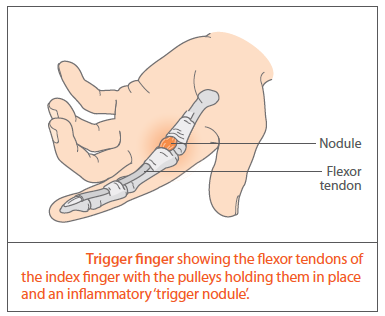Trigger finger
Trigger finger, or digital flexor stenosing tenosynovitis, is a condition characterised by localised restriction of extension in a digit other than the thumb
- there is a mismatch between the size of the tendon and its sheath making it difficult for the tendon to pass through a pulley.
Usually, flexion is normal but beyond a certain range of motion, the sufferer has difficulty extending the flexed finger. A snap is frequently felt as the obstruction is passed. There may be pain at the point of obstruction.
Clinically, a discrete nodule may be palpated along the line of the flexor tendon at the level of the A1, or more rarely, the A3 pulley. Alternatively, there may just be tenderness at this site.
The most commonly affected digits are the ring and middle fingers. The most commonly affected level is at the A1 pulley but occasionally it may occur at A3. The index finger is affected rarely. Similar pathological processes may occur in the flexor pollicis longus tendon - trigger thumb
- trigger finger (or thumb) occurs when the respective flexor tendon of a finger becomes thickened or develops a nodule
- upon flexion of the digit the nodule can become stuck behind one of several pulleys that hold the tendon down
- patient will describe the finger as locking in a flexed position; the finger can then often be manually straightened with a sudden release. This may be painful or occasionally pain-free
- exact cause of trigger finger is unknown; however it most commonly occurs in patients older than 40 years, more commonly in females than males. It may also be associated with underlying medical conditions such as RA or diabetes

Trigger finger is a common hand condition with a prevalence of 2.6% in the general population (2)
There are congenital forms of finger and thumb triggering - see linked item
Initially, the treatment of trigger finger may be medical, but frequently surgery provides definitive relief.
Reference:
- (1). Arthritis Research UK (April 2013). The upper limb in primary care. Part 2: Wrist, hand. Hands On 2(7).
- (2) Makkouk AH, Oetgen ME, Swigart CR, Dodds SD. Trigger finger: etiology, evaluation and treatment. Current Reviews in Musculoskeletal Medicine 2008;1(2):92-6
Create an account to add page annotations
Add information to this page that would be handy to have on hand during a consultation, such as a web address or phone number. This information will always be displayed when you visit this page